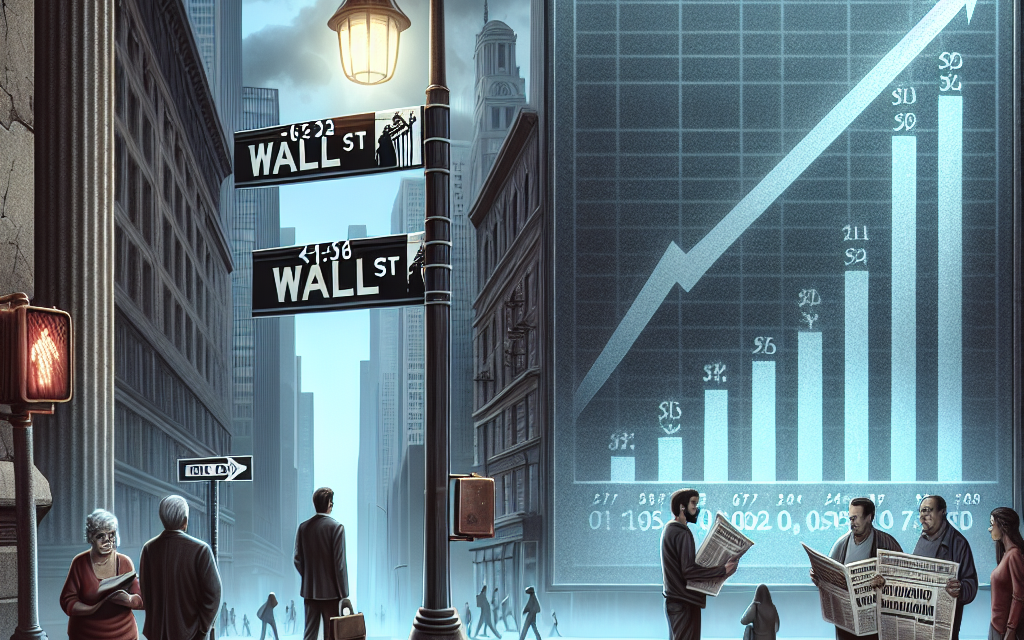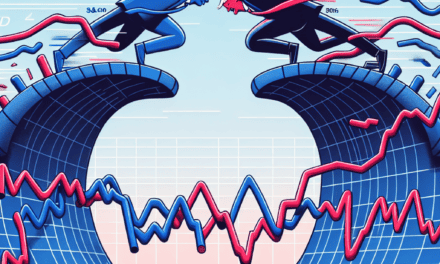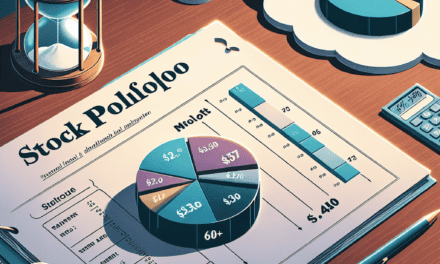“Wall Street Wavers: Inflation Fears Trigger Market Declines.”
Introduction
Wall Street experienced a notable decline as investors grappled with escalating inflation concerns that threaten economic stability. The recent surge in consumer prices has raised fears of tighter monetary policy from the Federal Reserve, prompting a sell-off in major stock indices. As inflationary pressures persist, market participants are increasingly wary of the potential impact on corporate earnings and consumer spending, leading to heightened volatility and uncertainty in the financial markets. This downturn reflects broader anxieties about the sustainability of the economic recovery in the face of rising costs and shifting fiscal policies.
Wall Street’s Reaction to Inflation Data
In recent weeks, Wall Street has experienced notable fluctuations, primarily driven by rising inflation concerns that have captured the attention of investors and analysts alike. As inflation data continues to emerge, the implications for the economy and financial markets have become increasingly significant. The latest reports indicate that inflation rates are climbing at a pace not seen in decades, prompting fears of a potential economic slowdown. This situation has led to a palpable sense of unease among market participants, who are grappling with the potential consequences of sustained inflation on corporate earnings and consumer spending.
The immediate reaction on Wall Street to the inflation data has been one of caution. Major indices, including the Dow Jones Industrial Average and the S&P 500, have experienced declines as investors reassess their positions in light of the new economic landscape. The volatility in the markets can be attributed to a combination of factors, including rising commodity prices, supply chain disruptions, and labor shortages, all of which contribute to the upward pressure on prices. As these elements converge, they create an environment where uncertainty reigns, leading to a sell-off in equities as investors seek to mitigate risk.
Moreover, the Federal Reserve’s response to inflation has become a focal point for market observers. The central bank has signaled its intention to combat rising prices through potential interest rate hikes and tapering of asset purchases. However, the timing and magnitude of these actions remain uncertain, further complicating the outlook for investors. As the Fed navigates the delicate balance between fostering economic growth and curbing inflation, Wall Street remains on edge, acutely aware that any misstep could have far-reaching consequences for the financial markets.
In addition to the Fed’s monetary policy considerations, the broader economic context plays a crucial role in shaping Wall Street’s reaction to inflation data. The labor market, while showing signs of recovery, still faces challenges that could hinder consumer spending. Wage growth, although positive, may not keep pace with rising prices, leading to diminished purchasing power for households. This scenario raises concerns about the sustainability of economic growth, as consumer sentiment is closely tied to inflationary pressures. Consequently, investors are closely monitoring economic indicators, such as retail sales and consumer confidence, to gauge the potential impact on corporate profitability.
As Wall Street grapples with these inflationary concerns, sector performance has also been uneven. Traditionally, sectors such as utilities and consumer staples tend to perform well during inflationary periods, as they provide essential goods and services that remain in demand regardless of economic conditions. Conversely, growth-oriented sectors, particularly technology, have faced headwinds as rising interest rates could dampen future earnings potential. This divergence in sector performance underscores the complexity of the current market environment, where investors must navigate a landscape marked by uncertainty and volatility.
In conclusion, Wall Street’s reaction to rising inflation concerns reflects a broader apprehension about the economic outlook. As inflation data continues to influence market sentiment, investors are left to weigh the potential ramifications of monetary policy decisions and economic indicators. The interplay between inflation, interest rates, and consumer behavior will undoubtedly shape the trajectory of the markets in the coming months. As such, market participants must remain vigilant, adapting their strategies to navigate the evolving landscape while keeping a close eye on the factors that drive inflation and its impact on the economy.
The Impact of Rising Inflation on Stock Market Performance
As inflation continues to rise, its impact on stock market performance has become a focal point for investors and analysts alike. The relationship between inflation and the stock market is complex, as rising prices can lead to both immediate and long-term consequences for various sectors. Initially, inflation can erode purchasing power, leading consumers to tighten their budgets. This reduction in consumer spending can adversely affect corporate earnings, which in turn may lead to a decline in stock prices. Consequently, as inflation expectations rise, investors often reassess their portfolios, leading to increased volatility in the market.
Moreover, the Federal Reserve’s response to inflation plays a crucial role in shaping market dynamics. When inflation rates climb, central banks may opt to increase interest rates in an effort to stabilize prices. Higher interest rates can lead to increased borrowing costs for both consumers and businesses, which can further dampen economic growth. As a result, sectors that are sensitive to interest rates, such as real estate and utilities, may experience significant declines in stock performance. Investors often react to these anticipated changes by reallocating their investments, which can exacerbate market fluctuations.
In addition to interest rate hikes, rising inflation can also lead to shifts in investor sentiment. When inflation is perceived as a persistent threat, investors may gravitate towards assets that traditionally perform well during inflationary periods, such as commodities or inflation-protected securities. This shift in focus can lead to a sell-off in equities, particularly in growth-oriented sectors that rely on future earnings projections. As investors become more risk-averse, the demand for stocks may diminish, resulting in a broader market decline.
Furthermore, the impact of inflation is not uniform across all sectors. For instance, companies that possess strong pricing power may be better positioned to pass on increased costs to consumers without significantly affecting demand. Conversely, businesses with thin profit margins may struggle to maintain profitability in an inflationary environment. This disparity can lead to a divergence in stock performance among different industries, creating opportunities for savvy investors who can identify which sectors are likely to thrive despite rising prices.
As inflationary pressures persist, the overall economic outlook becomes increasingly uncertain. Economic indicators such as consumer confidence, employment rates, and wage growth are closely monitored, as they can provide insights into how inflation is affecting the broader economy. A decline in consumer confidence, for example, may signal that households are feeling the pinch of rising prices, which could further dampen economic activity and negatively impact stock market performance.
In conclusion, the interplay between rising inflation and stock market performance is multifaceted and influenced by a variety of factors, including consumer behavior, central bank policies, and sector-specific dynamics. As inflation continues to be a pressing concern, investors must remain vigilant and adaptable, recognizing that the landscape can shift rapidly. By understanding the implications of inflation on different sectors and adjusting their strategies accordingly, investors can navigate the challenges posed by rising prices while seeking opportunities for growth in an uncertain market environment. Ultimately, the ability to anticipate and respond to these changes will be crucial for achieving long-term investment success in the face of inflationary pressures.
Strategies for Investors During Inflationary Periods
As inflationary pressures continue to mount, investors are faced with the challenge of navigating a financial landscape that is increasingly volatile and uncertain. In such an environment, it becomes imperative for investors to adopt strategies that not only protect their capital but also position them for potential growth. One of the most effective approaches during inflationary periods is to diversify investment portfolios. By spreading investments across various asset classes, such as equities, fixed income, real estate, and commodities, investors can mitigate risks associated with inflation. For instance, while traditional bonds may suffer due to rising interest rates, equities in sectors like energy or consumer staples often perform well as they can pass on increased costs to consumers.
Moreover, incorporating inflation-protected securities, such as Treasury Inflation-Protected Securities (TIPS), can serve as a hedge against inflation. These securities are designed to increase in value as inflation rises, thereby preserving purchasing power. Investors should also consider allocating a portion of their portfolios to real assets, such as real estate or commodities like gold and silver, which historically tend to retain value during inflationary periods. This strategy not only provides a buffer against inflation but also offers potential for capital appreciation.
In addition to diversifying asset classes, investors should remain vigilant about their investment choices within the equity market. Focusing on companies with strong pricing power can be particularly advantageous. These companies, often referred to as “pricing power stocks,” have the ability to raise prices without significantly impacting demand for their products or services. This characteristic allows them to maintain profit margins even as input costs rise. Furthermore, sectors such as utilities and consumer staples typically exhibit resilience during inflationary periods, making them attractive options for investors seeking stability.
Another critical strategy involves reassessing fixed-income investments. In an inflationary environment, the real returns on traditional bonds can diminish, prompting investors to explore alternatives such as floating-rate bonds or high-yield corporate bonds. Floating-rate bonds, which have interest payments that adjust with market rates, can provide a safeguard against rising interest rates, while high-yield bonds may offer higher returns that can outpace inflation. However, it is essential for investors to conduct thorough research and consider the credit risk associated with these investments.
Additionally, maintaining a long-term perspective is vital during inflationary periods. While short-term market fluctuations can be unsettling, history has shown that markets tend to recover over time. Therefore, investors should resist the temptation to make impulsive decisions based on short-term volatility. Instead, focusing on a well-thought-out investment strategy that aligns with long-term financial goals can yield more favorable outcomes.
Lastly, staying informed about economic indicators and central bank policies is crucial for making informed investment decisions. Understanding how monetary policy, interest rates, and inflation trends interact can provide valuable insights into market movements. By keeping abreast of these developments, investors can better anticipate changes in the economic landscape and adjust their strategies accordingly.
In conclusion, while rising inflation presents challenges for investors, it also offers opportunities for those who are willing to adapt their strategies. By diversifying portfolios, focusing on resilient sectors, reassessing fixed-income investments, maintaining a long-term perspective, and staying informed about economic trends, investors can navigate the complexities of an inflationary environment with greater confidence and resilience.
Historical Trends: Wall Street Declines and Inflation
Throughout history, Wall Street has experienced fluctuations that often correlate with rising inflation concerns. These economic cycles reveal a complex relationship between inflation rates and stock market performance, illustrating how investor sentiment can shift dramatically in response to changing economic indicators. As inflation rises, the purchasing power of consumers diminishes, leading to increased costs for businesses. This, in turn, can squeeze profit margins and create uncertainty in the market, prompting investors to reassess their positions.
In the late 1970s and early 1980s, the United States faced one of its most significant inflationary periods, characterized by soaring prices and high interest rates. During this time, the stock market struggled to maintain momentum, as investors grappled with the implications of persistent inflation on corporate earnings. The Federal Reserve’s aggressive monetary policy aimed at curbing inflation led to a recession, further exacerbating the decline in stock prices. This historical context serves as a reminder of how inflation can create a ripple effect throughout the economy, impacting not only consumer behavior but also corporate profitability and investor confidence.
Transitioning to more recent events, the aftermath of the 2008 financial crisis saw a prolonged period of low inflation and low interest rates, which contributed to a bull market that lasted nearly a decade. However, as the economy began to recover, inflationary pressures started to emerge once again. The COVID-19 pandemic further complicated this landscape, as supply chain disruptions and unprecedented fiscal stimulus measures led to a surge in demand, ultimately resulting in rising prices. As inflation expectations began to rise, Wall Street reacted with caution, reflecting the historical trend of declining stock prices amid inflationary concerns.
Moreover, the relationship between inflation and interest rates cannot be overlooked. When inflation rises, central banks often respond by increasing interest rates to stabilize prices. This tightening of monetary policy can lead to higher borrowing costs for consumers and businesses alike, which may dampen economic growth. Consequently, as interest rates rise, the attractiveness of equities may diminish, prompting investors to shift their portfolios toward safer assets such as bonds. This shift can lead to a decline in stock prices, further illustrating the historical trend of Wall Street’s response to inflationary pressures.
In addition to these economic factors, investor psychology plays a crucial role in shaping market dynamics. As inflation concerns mount, fear and uncertainty can lead to increased volatility in the stock market. Investors may react impulsively, selling off shares in anticipation of further declines, which can create a self-fulfilling prophecy. This phenomenon has been observed during various inflationary periods, where the mere expectation of rising prices can trigger a wave of selling, exacerbating market declines.
In conclusion, the historical trends of Wall Street declines amid rising inflation concerns highlight the intricate interplay between economic indicators, investor sentiment, and market performance. As inflation continues to be a focal point for policymakers and investors alike, understanding these historical patterns can provide valuable insights into potential future market behavior. By examining past cycles, one can better appreciate the complexities of the financial landscape and the factors that drive market fluctuations in response to inflationary pressures.
Sector Analysis: Which Industries Are Most Affected by Inflation?
As inflation continues to rise, its impact on various sectors of the economy becomes increasingly pronounced, leading to significant shifts in market dynamics. The financial markets, particularly Wall Street, have reacted to these inflationary pressures with notable declines, prompting investors to reassess their strategies. Understanding which industries are most affected by inflation is crucial for navigating this turbulent economic landscape.
One of the most directly impacted sectors is consumer goods, particularly those that fall under the category of staples. As inflation drives up the cost of raw materials and production, companies in this sector face increased expenses that can erode profit margins. Consequently, many of these firms may pass on the higher costs to consumers, leading to reduced demand for their products. This cycle can create a challenging environment for consumer staples, as price-sensitive customers may seek alternatives or cut back on spending altogether. Thus, while some companies may attempt to maintain their pricing power, the overall effect of inflation can lead to a contraction in sales volume.
In contrast, the energy sector often experiences a different set of dynamics during inflationary periods. Rising prices for oil and gas can initially benefit energy companies, as they can command higher prices for their products. However, this sector is not immune to the broader economic implications of inflation. For instance, if inflation leads to increased interest rates, the cost of capital for energy projects may rise, potentially stalling new investments and expansion plans. Furthermore, as consumers face higher prices across the board, discretionary spending on energy-intensive activities may decline, ultimately affecting demand for energy products.
The technology sector also faces unique challenges in an inflationary environment. While technology companies often enjoy high margins and robust growth, they are not insulated from rising costs. Supply chain disruptions, which have been exacerbated by inflation, can lead to delays and increased expenses for tech firms reliant on semiconductor chips and other components. Additionally, as inflation prompts central banks to consider tightening monetary policy, the cost of borrowing may rise, impacting the ability of tech companies to finance growth initiatives. This potential shift in the cost of capital can lead to a reevaluation of valuations in the tech sector, contributing to market volatility.
Moreover, the financial sector is intricately linked to inflationary trends. Banks and financial institutions may benefit from rising interest rates, as they can charge more for loans. However, if inflation leads to economic uncertainty, the risk of defaults may increase, which could offset any potential gains. Furthermore, the overall health of the economy plays a critical role in determining the performance of financial institutions. If inflation leads to a slowdown in economic growth, the financial sector may face headwinds that could dampen profitability.
Lastly, the real estate sector often reacts to inflation in complex ways. On one hand, rising prices can lead to increased property values and rental income, benefiting real estate investment trusts (REITs) and property owners. On the other hand, higher inflation can lead to increased borrowing costs, making it more difficult for potential buyers to enter the market. This duality creates a challenging environment for real estate investors, as they must navigate the interplay between rising costs and potential demand fluctuations.
In conclusion, the effects of rising inflation are felt across various sectors, each responding differently to the economic pressures at play. As Wall Street grapples with these challenges, understanding the nuances of how inflation impacts different industries will be essential for investors seeking to make informed decisions in an increasingly volatile market.
The Role of Federal Reserve Policies in Wall Street Fluctuations
The fluctuations of Wall Street are often closely tied to the policies enacted by the Federal Reserve, which plays a pivotal role in shaping the economic landscape of the United States. As inflation concerns rise, the actions and decisions of the Federal Reserve become increasingly scrutinized by investors and analysts alike. The central bank’s primary mandate is to promote maximum employment and stable prices, but when inflation begins to surge, the Fed faces a delicate balancing act. This balancing act can lead to significant volatility in the stock market, as investors react to the potential implications of monetary policy changes.
When inflation rates climb, the Federal Reserve typically responds by adjusting interest rates. Higher interest rates can dampen consumer spending and business investment, as borrowing costs increase. Consequently, this can lead to a slowdown in economic growth, which is often reflected in the performance of stocks. Investors, anticipating these changes, may begin to sell off shares, leading to a decline in stock prices. This reaction is particularly pronounced in sectors that are sensitive to interest rate changes, such as technology and real estate, where future earnings are discounted more heavily when rates rise.
Moreover, the Federal Reserve’s communication strategy plays a crucial role in shaping market expectations. The central bank often provides guidance on its future policy intentions, which can either reassure or unsettle investors. For instance, if the Fed signals a more aggressive approach to combating inflation, such as a series of rate hikes, market participants may react swiftly, leading to increased volatility. Conversely, if the Fed adopts a more dovish stance, indicating a willingness to keep rates low for an extended period, it can bolster investor confidence and lead to market rallies. Thus, the Fed’s rhetoric and policy decisions are instrumental in influencing market sentiment.
In addition to interest rates, the Federal Reserve’s quantitative easing measures also impact Wall Street. During periods of economic uncertainty, the Fed may engage in asset purchases to inject liquidity into the financial system. This influx of capital can drive up asset prices, including stocks, as investors seek higher returns in a low-interest-rate environment. However, as inflation concerns mount, the Fed may signal a tapering of these asset purchases, which can lead to a reassessment of risk and a subsequent decline in stock prices. The interplay between monetary policy and market dynamics underscores the importance of the Fed’s role in Wall Street fluctuations.
Furthermore, external factors such as geopolitical tensions, supply chain disruptions, and global economic conditions can exacerbate the impact of Federal Reserve policies on the stock market. For instance, if inflation is driven by supply chain issues or rising commodity prices, the Fed’s ability to control inflation through interest rate adjustments may be limited. In such scenarios, investors may become increasingly anxious, leading to heightened market volatility. The interconnectedness of global markets means that Wall Street is not only influenced by domestic policies but also by international developments.
In conclusion, the role of Federal Reserve policies in Wall Street fluctuations cannot be overstated. As inflation concerns rise, the central bank’s decisions regarding interest rates and asset purchases become critical in shaping market dynamics. Investors closely monitor the Fed’s actions and communications, as these can significantly influence market sentiment and stock performance. Ultimately, the relationship between Federal Reserve policies and Wall Street is complex, reflecting a myriad of economic factors that contribute to the ongoing fluctuations in the financial markets.
Future Outlook: Wall Street and Inflation Predictions
As Wall Street grapples with the implications of rising inflation, the future outlook for the financial markets remains uncertain. Investors are increasingly concerned about the potential for sustained inflationary pressures, which could significantly impact economic growth and corporate profitability. The recent uptick in consumer prices has prompted analysts to reassess their forecasts, leading to a cautious sentiment that permeates trading floors across the nation.
In the wake of these inflationary concerns, the Federal Reserve’s monetary policy decisions will play a crucial role in shaping market dynamics. Historically, the Fed has responded to rising inflation by tightening monetary policy, which often involves increasing interest rates. Such actions can lead to higher borrowing costs for consumers and businesses alike, potentially stifling economic expansion. Consequently, investors are closely monitoring the central bank’s signals regarding future rate hikes, as any indication of a more aggressive stance could further exacerbate market volatility.
Moreover, the interplay between inflation and interest rates is not the only factor influencing Wall Street’s trajectory. Supply chain disruptions, which have been exacerbated by the ongoing global pandemic, continue to contribute to rising costs for businesses. These disruptions have led to shortages in key materials and labor, forcing companies to pass on increased expenses to consumers. As a result, inflationary pressures may persist, prompting a reevaluation of corporate earnings forecasts. Analysts are now considering how these factors will affect various sectors, particularly those that are more sensitive to changes in consumer spending and input costs.
In addition to these economic indicators, geopolitical tensions and their potential impact on global markets cannot be overlooked. Events such as trade disputes, conflicts, and regulatory changes can create uncertainty that further complicates the inflation narrative. For instance, if tensions escalate in key regions, it could lead to disruptions in oil supply, driving energy prices higher and contributing to overall inflation. Investors must remain vigilant, as these external factors can have far-reaching consequences for market stability.
As Wall Street navigates this complex landscape, the sentiment among investors is one of cautious optimism. While some analysts predict that inflation may eventually stabilize as supply chains recover and consumer demand normalizes, others warn that structural changes in the economy could lead to a new era of higher prices. This divergence in outlook underscores the importance of remaining adaptable in investment strategies. Diversification may become increasingly critical as investors seek to mitigate risks associated with inflation and interest rate fluctuations.
Looking ahead, it is essential for market participants to stay informed about economic indicators and central bank communications. The ability to interpret these signals will be vital in making informed investment decisions. Furthermore, as companies report their earnings, the focus will likely shift to how they are managing inflationary pressures and whether they can maintain profitability in a challenging environment.
In conclusion, the future outlook for Wall Street amid rising inflation concerns is marked by uncertainty and complexity. As investors navigate this evolving landscape, they must remain vigilant and adaptable, ready to respond to both economic indicators and geopolitical developments that could shape market dynamics in the months to come. The interplay between inflation, interest rates, and external factors will undoubtedly continue to influence investor sentiment and market performance, making it imperative to stay informed and proactive in the face of change.
Q&A
1. **Question:** What recent economic factor has contributed to Wall Street’s decline?
**Answer:** Rising inflation concerns have contributed to Wall Street’s decline.
2. **Question:** How does inflation typically affect stock market performance?
**Answer:** Inflation can erode purchasing power and lead to higher interest rates, which often negatively impacts stock market performance.
3. **Question:** What specific inflation indicators have raised concerns among investors?
**Answer:** Increases in consumer prices, such as the Consumer Price Index (CPI) and Producer Price Index (PPI), have raised concerns.
4. **Question:** How have central banks responded to rising inflation?
**Answer:** Central banks, such as the Federal Reserve, have indicated potential interest rate hikes to combat rising inflation.
5. **Question:** What sectors of the market are most affected by inflation fears?
**Answer:** Sectors such as technology and consumer discretionary are often most affected by inflation fears due to their sensitivity to interest rates.
6. **Question:** What impact does rising inflation have on consumer spending?
**Answer:** Rising inflation can lead to decreased consumer spending as higher prices reduce disposable income.
7. **Question:** What strategies might investors consider during periods of high inflation?
**Answer:** Investors might consider diversifying their portfolios, investing in inflation-protected securities, or focusing on commodities and real assets.
Conclusion
Wall Street’s decline amid rising inflation concerns reflects investor anxiety over potential interest rate hikes and the impact on economic growth. As inflation persists, market volatility is likely to continue, prompting a cautious approach from investors as they navigate the challenges posed by higher prices and tightening monetary policy.





